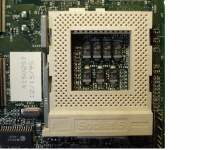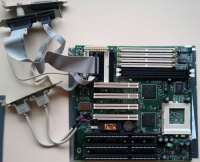Difference between revisions of "Socket 5 / 7 / Super-7 Motherboards"
RacoonRider (Talk | contribs) (→Socket 7) |
|||
| Line 2: | Line 2: | ||
== Socket 5 == | == Socket 5 == | ||
[[File:Socket5.jpg|200px|thumb||Socket 5]] | [[File:Socket5.jpg|200px|thumb||Socket 5]] | ||
| − | Socket 5 was the | + | Socket 5 was developed for the Pentium "P54C" CPU that operated at 3.3v instead of the original P5's 5.0v. This was a die shrink revision of the Pentium and operated at 75-120MHz with a bus speed of either 60MHz or 66MHz. |
| − | + | ||
| − | + | ||
| − | + | ||
| − | + | There are several CPUs from companies other than Intel available for Socket 5. The Centaur/IDT Winchip and the AMD K5 are perhaps most well known. There are also several Intel Pentium Overdrive CPUs that were produced to match Socket 5 options to later Socket 7 CPU clock speeds. | |
| − | Socket 5 | + | Socket 5 motherboards are built to the AT specification, and typically use PCI and ISA slots. There were some with VLB slots as well, and some have onboard audio or video. |
| − | == | + | === Chipsets === |
| + | *'''430NX "Neptune"''' - PIO IDE. IDE controller may be buggy. FPM DRAM. Asynchronous cache. 512 MB cacheable RAM limit. 512 MB max RAM. | ||
| + | *'''430FX "Triton"''' - 16 MB/s DMA IDE, EDO DRAM, and pipeline burst synchronous cache options. 64 MB cacheable RAM limit. 128 MB max RAM. | ||
| − | |||
| − | Socket 7 | + | == Socket 7 == |
| − | + | [[File:ATC-5030_430TX.jpg|200px|thumb||Socket 7 Motherboard]] | |
| − | + | ||
| − | Socket 7 | + | Socket 7 brings "split-rail" support for CPUs, which is required for the Pentium MMX "P55C" CPU. Official bus speeds are typically 60 and 66 MHz, but some motherboards allow a wider range to support some models of non-Intel CPUs. Alternative CPUs include products from Cyrix, AMD, Rise and IDT/Centaur. |
| − | + | Socket 7 motherboards are available in AT and ATX form factor. They have PCI and ISA slots. Some have extra onboard components like audio and video. | |
| − | + | === Chipsets === | |
| + | ==== Intel ==== | ||
| + | *'''430HX "Triton"''' - 16 MB/s DMA IDE, EDO DRAM, and pipeline burst synchronous cache options. Supports either 64 MB or 512 MB cacheable RAM. 512 MB RAM max. | ||
| + | *'''430VX "Triton"''' - 16 MB/s DMA IDE, EDO DRAM, 2clk SDRAM, and pipeline burst synchronous cache options. 64 MB cacheable limit. 128 MB max RAM. Slightly slower than 430HX. | ||
| + | *'''430TX''' - 33 MB/s UDMA IDE, EDO, 2clk SDRAM, and pipeline burst synchronous cache options. 64 MB cacheable limit. 128 MB max RAM. | ||
== Super Socket 7 == | == Super Socket 7 == | ||
| − | Super Socket 7 | + | Super Socket 7 is an AMD creation. They modernized the Socket 7 platform with AGP and 100 MHz bus support for their K6-2 processor. Intel was not involved with this nor did they produce CPUs specifically for it. |
| − | + | Chipsets were produced by ALI, VIA and SiS. The boards come in AT and ATX form factors and usually have AGP, PCI and ISA. Some boards use integrated graphics and forgo the AGP slot. | |
| − | + | ||
| − | + | ||
| − | + | These solutions competed against Intel Celeron and Pentium II. | |
| − | + | ||
Revision as of 08:49, 27 February 2013
Socket 5
Socket 5 was developed for the Pentium "P54C" CPU that operated at 3.3v instead of the original P5's 5.0v. This was a die shrink revision of the Pentium and operated at 75-120MHz with a bus speed of either 60MHz or 66MHz.
There are several CPUs from companies other than Intel available for Socket 5. The Centaur/IDT Winchip and the AMD K5 are perhaps most well known. There are also several Intel Pentium Overdrive CPUs that were produced to match Socket 5 options to later Socket 7 CPU clock speeds.
Socket 5 motherboards are built to the AT specification, and typically use PCI and ISA slots. There were some with VLB slots as well, and some have onboard audio or video.
Chipsets
- 430NX "Neptune" - PIO IDE. IDE controller may be buggy. FPM DRAM. Asynchronous cache. 512 MB cacheable RAM limit. 512 MB max RAM.
- 430FX "Triton" - 16 MB/s DMA IDE, EDO DRAM, and pipeline burst synchronous cache options. 64 MB cacheable RAM limit. 128 MB max RAM.
Socket 7
Socket 7 brings "split-rail" support for CPUs, which is required for the Pentium MMX "P55C" CPU. Official bus speeds are typically 60 and 66 MHz, but some motherboards allow a wider range to support some models of non-Intel CPUs. Alternative CPUs include products from Cyrix, AMD, Rise and IDT/Centaur.
Socket 7 motherboards are available in AT and ATX form factor. They have PCI and ISA slots. Some have extra onboard components like audio and video.
Chipsets
Intel
- 430HX "Triton" - 16 MB/s DMA IDE, EDO DRAM, and pipeline burst synchronous cache options. Supports either 64 MB or 512 MB cacheable RAM. 512 MB RAM max.
- 430VX "Triton" - 16 MB/s DMA IDE, EDO DRAM, 2clk SDRAM, and pipeline burst synchronous cache options. 64 MB cacheable limit. 128 MB max RAM. Slightly slower than 430HX.
- 430TX - 33 MB/s UDMA IDE, EDO, 2clk SDRAM, and pipeline burst synchronous cache options. 64 MB cacheable limit. 128 MB max RAM.
Super Socket 7
Super Socket 7 is an AMD creation. They modernized the Socket 7 platform with AGP and 100 MHz bus support for their K6-2 processor. Intel was not involved with this nor did they produce CPUs specifically for it.
Chipsets were produced by ALI, VIA and SiS. The boards come in AT and ATX form factors and usually have AGP, PCI and ISA. Some boards use integrated graphics and forgo the AGP slot.
These solutions competed against Intel Celeron and Pentium II.

